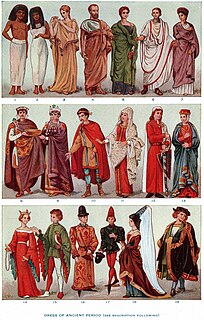Fashion is a popular style, especially in clothing, footwear, lifestyle, accessories, makeup, hairstyle and body. Fashion is a distinctive and often constant trend in the style in which people present themselves. A fashion can become the prevailing style in behaviour or manifest the newest creations of designers, technologists, engineers, and design managers.

Gothic fashion is a clothing style marked by conspicuously dark, mysterious, antiquated and homogeneous features. It is worn by members of the Goth subculture. A dark, sometimes morbid fashion and style of dress, typical gothic fashion includes a pale complexion with colored black hair, black lips and black clothes. Both male and female goths can wear dark eyeliner and dark fingernail polish most especially black. Styles are often borrowed from the punk fashion, Victorians and Elizabethans. Goth fashion is sometimes confused with heavy metal fashion and emo fashion.

A subculture is a group of people within a culture that differentiates itself from the parent culture to which it belongs, often maintaining some of its founding principles. Subcultures develop their own norms and values regarding cultural, political and sexual matters. Subcultures are part of society while keeping their specific characteristics intact. Examples of subcultures include hippies, goths and bikers. The concept of subcultures was developed in sociology and cultural studies. Subcultures differ from countercultures.

The New Romantic movement was a pop culture movement that originated in the United Kingdom in the late 1970s. The movement emerged from the nightclub scene in London and Birmingham at venues such as Billy's and The Blitz. The New Romantic movement was characterized by flamboyant, eccentric fashion inspired by fashion boutiques such as Kahn and Bell in Birmingham and PX in London. Early adherents of the movement were often referred to by the press by such names as Blitz Kids, New Dandies and Romantic Rebels.
Preppy or prep is a subculture in the United States associated with old private Northeastern university-preparatory schools. The terms are used to denote a person seen as characteristic of a student or alumnus of these schools. Characteristics of preps in the past include a particular subcultural speech, vocabulary, dress, mannerisms, etiquette, reflective of an upper-class upbringing.

Mod is a subculture that began in London in 1958 and spread throughout Great Britain and elsewhere, eventually influencing fashions and trends in other countries, and continues today on a smaller scale. Focused on music and fashion, the subculture has its roots in a small group of stylish London-based young men in the late 1950s who were termed modernists because they listened to modern jazz. elements of the mod subculture include fashion ; music ; and motor scooters. The original mod scene was associated with amphetamine-fuelled all-night dancing at clubs.
The casual subculture is a subsection of football culture that is typified by hooliganism and the wearing of expensive designer clothing. The subculture originated in the United Kingdom in the early 1980s when many hooligans started wearing designer clothing labels and expensive sportswear such as Stone Island, CP Company, L'alpina, Lacoste, Sergio Tacchini, Fila and Ellesse in order to avoid the attention of police and to intimidate rivals. They did not wear club colours, so it was allegedly easier to infiltrate rival groups and to enter pubs. Some casuals have worn clothing items similar to those worn by mods. Casuals have been portrayed in films and television programmes such as ID, The Firm and The Football Factory.
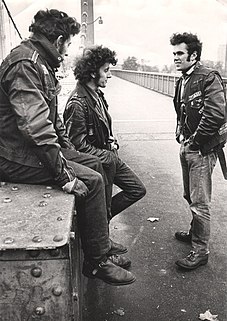
Rockers, leather boys, Ton-up boys, and possibly café racers are members of a biker subculture that originated in the United Kingdom during the 1950s. It was mainly centred on British café racer motorcycles and rock 'n' roll music. By 1965, the term greaser had also been introduced to Great Britain and, since then, the terms greaser and rocker have become synonymous within the British Isles although used differently in North America and elsewhere. Rockers were also derisively known as Coffee Bar Cowboys. Their Japanese counterpart was called the Kaminari-Zoku.

Cleavage is the exposed area between a woman’s breasts lying over the sternum, and refers only to what is visible with clothing that includes a low-cut neckline. In some cultures, display of cleavage is considered aesthetic or erotic, and may be associated with garments with low necklines that expose or highlight cleavage, such as ball gowns, evening gowns, lingerie, and swimwear. In these cultures women have, throughout history, sought to enhance their physical attractiveness and femininity, within the context of changing fashions and cultural-specific norms of modesty of the time and place. The methods practised in appropriate contexts have included the accentuation and partial display of breasts, including cleavage. In some cultures any display of cleavage may be culturally taboo illegal or otherwise socially disapproved.

Taffeta is a crisp, smooth, plain woven fabric made from silk or cuprammonium rayons as well as acetate and polyester. The word is Persian in origin and means "twisted woven". It is considered to be a "high-end" fabric, suitable for use in ball gowns, wedding dresses, and in interior decoration for curtains or wallcoverings. It is also widely used in the manufacture of corsets and corsetry: it yields a more starched-like type of cloth that holds its shape better than many other fabrics. An extremely thin, crisp type of taffeta is called paper taffeta.
Cinéma du look was a French film movement of the 1980s, analysed, for the first time, by French critic Raphaël Bassan in La Revue du Cinéma issue n° 448, May 1989, in which he classified Luc Besson, Jean-Jacques Beineix and Leos Carax as directors of "le look". These directors were said to favor style over substance, spectacle over narrative. It referred to films that had a slick, gorgeous visual style and a focus on young, alienated characters who were said to represent the marginalized youth of François Mitterrand's France. Themes that run through many of their films include doomed love affairs, young people more affiliated to peer groups than families, a cynical view of the police, and the use of scenes in the Paris Métro to symbolise an alternative, underground society. The mixture of 'high' culture, such as the opera music of Diva and Les Amants du Pont-Neuf, and pop culture, for example the references to Batman in Subway, was another key feature.

A justacorps or justaucorps is a long, knee-length coat worn by men in the latter half of the 17th century, and throughout the 18th century. The garment is of French origin, and was introduced in England as a component of a three-piece ensemble, also consisting of breeches and a long vest or waistcoat. This ensemble served as the prototype of the modern-day three-piece suit. The fabric selection and styling of the justacorps varied throughout time periods, as fashions frequently altered.

A dress is a garment consisting of a skirt with an attached bodice. It consists of a top piece that covers the torso and hangs down over the legs. A dress can be any one-piece garment containing a skirt of any length. Dresses can be formal or informal. In many cultures, dresses are more often worn by women and girls.
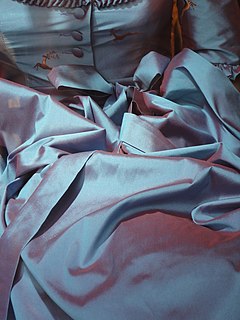
Shot silk is a fabric which is made up of silk woven from warp and weft yarns of two or more colours producing an iridescent appearance. A "shot" is a single throw of the bobbin that carries the weft thread through the warp, and shot silk colours can be described as "[warp colour] shot with [weft colour]." The weaving technique can also be applied to other fibres such as cotton, linen, and synthetics.

Ted Polhemus is an American anthropologist, writer, and photographer who lives and works on England's south coast. His work focuses on fashion and anti-fashion, identity, and the sociology of style and of the body – his objective, to explore the social and communicative importance of personal expression in style. He has written or edited more than a dozen books, and has taken many of the photographs that appear in them. He was the creator and curator of an exhibition, called "StreetStyle", at the Victoria & Albert Museum in London. One of his most popular books is "Streetstyle: From Sidewalk to Catwalk", which he originally wrote as the book for the exhibition. Ted Polhemus wrote an updated version of Streetstyle, which PYMCA published in 2010.In 2011 he published a revised and expanded version of his early book Fashion & Anti-fashion. Most recently, he has been exploring the social and cultural impact of the baby boom generation and this has culminated in the publication in 2012 of BOOM! - A Baby Boomer Memoir, 1947-22.
Max Scratchmann is a British illustrator and author.
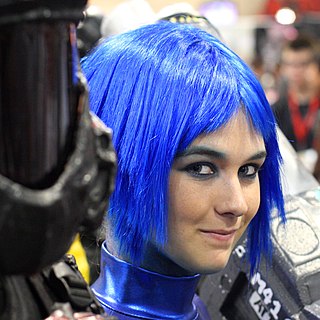
Blue hair is a type of hair color that does not naturally occur in human hair pigmentation, although the hair of some animals is described as blue. Some humans are born with bluish-black hair, which is black that has a blue hue under the light.
The black Givenchy dress of Audrey Hepburn is a little black dress designed by Hubert de Givenchy and worn by Audrey Hepburn in the opening of the 1961 romantic comedy film Breakfast at Tiffany's. The dress is cited as one of the most iconic items of clothing in the history of the twentieth century and perhaps the most famous "little black dress" of all time.

The great Scottish witch hunt of 1649–50 was a series of witch trials in Scotland. It is one of five major hunts identified in early modern Scotland and it probably saw the most executions in a single year.
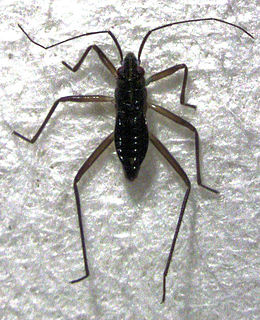
Mesoveliidae is a family of water treaders in the order Hemiptera. There are about 16 genera and at least 50 described species in Mesoveliidae.
